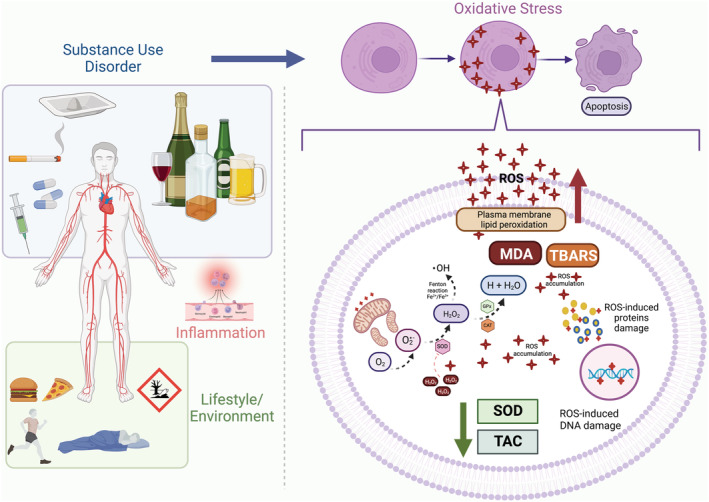FIGURE 3.

Oxidative stress and substance use disorders. The lifestyle and adverse environmental exposure related to substance use disorders (SUD) are characterized by chronic stress, use of multiple drugs, increased exposure to infections, financial problems, sleep disturbances, insufficient exercise and poor nutrition. All those factors are associated with the activation of the immune system and oxidative stress. NADPH oxidases, xanthine oxidase and the mitochondrial electron‐transport chain can act as active sources of reactive oxygen species (ROS), mainly producing the radical superoxide. SUD can increase reactive oxygen species (ROS) production and negatively affect enzymatic and non‐enzymatic antioxidant capacity. As an effect of this imbalance, biomolecules such as lipids, proteins and DNA can be modified by ROS, having their function disrupted and even ending up in cell death. Participants with SUD, particularly alcohol use disorder, presented elevated levels of lipid damage biomarkers (malondialdehyde [MDA], thiobarbituric acid reactive substances [TBARSs] and lipid peroxidation), reduced superoxide dismutase (SOD) activity and a reduction of total antioxidant capacity (TAC). These results can help to explain the cellular mechanisms and metabolic changes associated with SUD, particularly outcomes related with accelerated ageing. CAT, catalase; Fe, iron; GPx, glutathione peroxidase; H, hydrogen; H2O, water; H2O2, hydrogen peroxide; NADPH, reduced nicotinamide adenine dinucleotide phosphate; O2, oxygen; , radical superoxide; •OH, radical hydroxyl; ROS, reactive oxygen species. Created with BioRender.com
